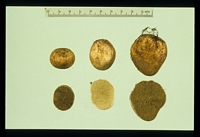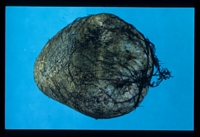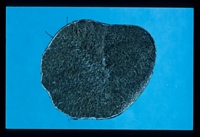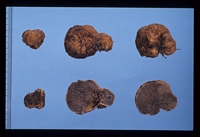|
 Rhizopogon luteolus Rhizopogon luteolus
SynonymsRhizopogon induratus
Rhizopogon wilsonii
Melanogaster wilsonii
BiostatusPresent in region - Exotic
Images (click to enlarge)
Caption: FIG. 1. R. luteolus: A Habit and section (Beaton 70) x 1; B spores x 1750; C basidia x 1000. | 
Caption: REB136, 9/6/82, waipoua
Owner: Ross Beever | 
Caption: REB136, 9/6/82, waipoua
Owner: Ross Beever | 
Caption: REB136, 9/6/82, Waipoua
Owner: Ross Beever | 
Caption: REB2-A, 23/4/79, Pinus, Waitakare
Owner: Ross Beever |
Article: Beaton, G.W.; Pegler, D.N.; Young, T.W.K. (1985). Gasteroid Basidiomycota of Victoria State, Australia: 5–7. Kew Bulletin 40(3): 573–598.
Description: Gasterocarp 1-3 cm diam., irregularly subglobose to ellipsoid, basally or laterally attached by numerous, fine rhizomorphs which blacken on drying.
Peridium initially whitish soon yellow brown (M.8.5YR/5.5/2.8), smooth to rugose, not viscid, drying very hard, finally cracked. Gleba almost
concolorous with peridium becoming dingy olive-yellow, composed of minute, labyrinthoid, partially filled chambers, 0.1-0 3 mm diam., with the
thin, white tramal plates giving a marbled appearance. Tramal plates 100- 225 µm thick, white, composed of a narrow, gelatinized hymenophoral
trama, and well developed subhymenial layers; peridial context well developed, similar in structure to the hymenophoral trama but hyphae less
gelatinized; clamp-connexions absent. Spores 5.5-7.5 x 2.5-3.5(6.5 ± 0.5 x 3 ± 0.3) µm, Q= 2.16, symmetric, oblong-ellipsoid, subtruncated at the
base, hyaline becoming pale olive-brown, with a thickened smooth wall, with biguttulate contents; sometimes a short sterigmal appendage is retained
at the base. Basidia 25-30 x 8-9 µm, lageniform with a ventricose base and a cylindrico-tapering apex, hyaline, thin-walled, bearing six, or sometimes
four, short apical sterigmata; numerous immature, piriform basidia also present. Hymenophoral trama subregular, narrow, hyaline, of subparallel to
loosely woven hyphae, 2.5-6 µm diam., with a gelatinized, refractive wall and a narrow lumen. Subhymenial layer 13-20µm wide, well developed,
pseudoparenchymatous. Peridiopellis a loosely woven epicutis, 50-70µm thick, of repent hyphae, 3-6µm diam., thin-walled, with a fine granular,
brown, encrusting pigment, also irregular, amorphous, brown pigment deposits present.
Notes: The type species of Rhizopogon has a world-wide distribution but is almost certainly introduced with pine under which the gasterocarps are to be
found buried or half-buried in the litter of fallen pine-needles. It is frequently confused with R. rubescens but may be distinguished by the smaller
spores, the absence of reddish tints or stains, and the hymenophoral trama which is more strongly gelatinized resulting in a very hard gleba on drying.
In both the type collection of R. induratus, described from New Zealand, and the Victoria State collection, Beaton 70, the entire gasterocarp had dried to a bone hard consistency.
Article: Cooke, M.C. (1879). New Zealand fungi. Grevillea 8(46): 54-68.
Article: Gadgil, P.D. (in association with Dick, M.A.; Hood, I.A.; Pennycook, S.R.) (2005). Fungi on trees and shrubs in New Zealand. Fungi of New Zealand. Ngā Harore o Aotearoa 4: xi + 437 p. Hong Kong: Fungal Diversity Press.
Description: Type: Mycorrhizal Fungi; Description: Basidiomata hypogeous to subepigeous, subglobose to oblong, yellowish brown to rusty brown often with a yellowish tinge, up to 30 mm in diameter; rhizomorphs well developed, dark brown to black; peridium composed of a single layer, ochraceous in section. Gleba firm, white at first, becoming yellowish brown later, consisting of persistent tramal plates anastomosing to form labrynthiform cavities filled with basidiospores. Basidiospores elliptical, 0-septate, 6–9 × 3–4 μm, smooth, yellowish.
Distribution: Distribution: Northland, Auckland, Coromandel, Waikato, Bay of Plenty, Wanganui, Gisborne, Hawkes Bay, Nelson, Buller, Westland, North Canterbury, Mid Canterbury, Dunedin, Southland.; 1st Record: Chu-Chou (1979).
Article: Cooke, M.C. (1879). New Zealand fungi. Grevillea 8(46): 54-68.
Notes: About one inch in diameter. When dry it is exceedingly hard, so that it can scarcely be cut;
the surface then resembles buffalo horn.
|